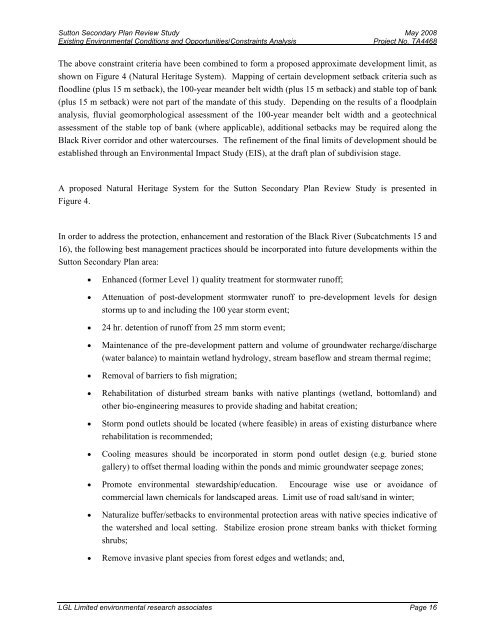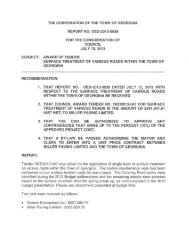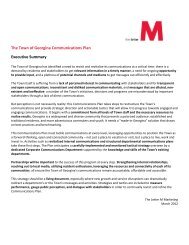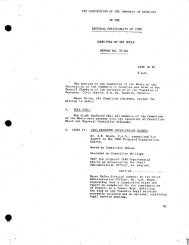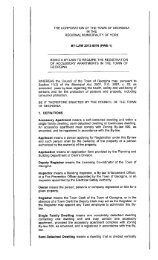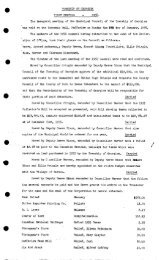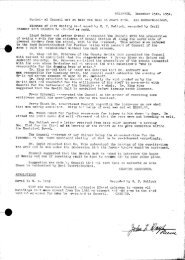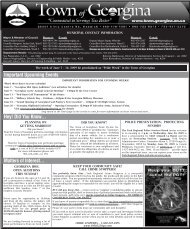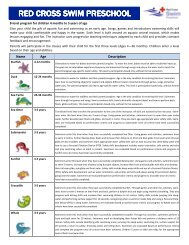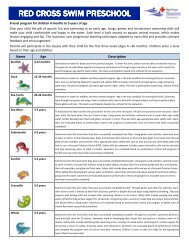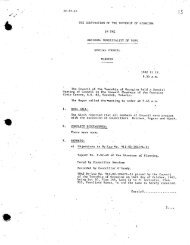Background Report - Town of Georgina
Background Report - Town of Georgina
Background Report - Town of Georgina
You also want an ePaper? Increase the reach of your titles
YUMPU automatically turns print PDFs into web optimized ePapers that Google loves.
Sutton Secondary Plan Review Study May 2008<br />
Existing Environmental Conditions and Opportunities/Constraints Analysis<br />
Project No. TA4468<br />
The above constraint criteria have been combined to form a proposed approximate development limit, as<br />
shown on Figure 4 (Natural Heritage System). Mapping <strong>of</strong> certain development setback criteria such as<br />
floodline (plus 15 m setback), the 100-year meander belt width (plus 15 m setback) and stable top <strong>of</strong> bank<br />
(plus 15 m setback) were not part <strong>of</strong> the mandate <strong>of</strong> this study. Depending on the results <strong>of</strong> a floodplain<br />
analysis, fluvial geomorphological assessment <strong>of</strong> the 100-year meander belt width and a geotechnical<br />
assessment <strong>of</strong> the stable top <strong>of</strong> bank (where applicable), additional setbacks may be required along the<br />
Black River corridor and other watercourses. The refinement <strong>of</strong> the final limits <strong>of</strong> development should be<br />
established through an Environmental Impact Study (EIS), at the draft plan <strong>of</strong> subdivision stage.<br />
A proposed Natural Heritage System for the Sutton Secondary Plan Review Study is presented in<br />
Figure 4.<br />
In order to address the protection, enhancement and restoration <strong>of</strong> the Black River (Subcatchments 15 and<br />
16), the following best management practices should be incorporated into future developments within the<br />
Sutton Secondary Plan area:<br />
• Enhanced (former Level 1) quality treatment for stormwater run<strong>of</strong>f;<br />
• Attenuation <strong>of</strong> post-development stormwater run<strong>of</strong>f to pre-development levels for design<br />
storms up to and including the 100 year storm event;<br />
• 24 hr. detention <strong>of</strong> run<strong>of</strong>f from 25 mm storm event;<br />
• Maintenance <strong>of</strong> the pre-development pattern and volume <strong>of</strong> groundwater recharge/discharge<br />
(water balance) to maintain wetland hydrology, stream baseflow and stream thermal regime;<br />
• Removal <strong>of</strong> barriers to fish migration;<br />
• Rehabilitation <strong>of</strong> disturbed stream banks with native plantings (wetland, bottomland) and<br />
other bio-engineering measures to provide shading and habitat creation;<br />
• Storm pond outlets should be located (where feasible) in areas <strong>of</strong> existing disturbance where<br />
rehabilitation is recommended;<br />
• Cooling measures should be incorporated in storm pond outlet design (e.g. buried stone<br />
gallery) to <strong>of</strong>fset thermal loading within the ponds and mimic groundwater seepage zones;<br />
• Promote environmental stewardship/education. Encourage wise use or avoidance <strong>of</strong><br />
commercial lawn chemicals for landscaped areas. Limit use <strong>of</strong> road salt/sand in winter;<br />
• Naturalize buffer/setbacks to environmental protection areas with native species indicative <strong>of</strong><br />
the watershed and local setting. Stabilize erosion prone stream banks with thicket forming<br />
shrubs;<br />
• Remove invasive plant species from forest edges and wetlands; and,<br />
LGL Limited environmental research associates Page 16


